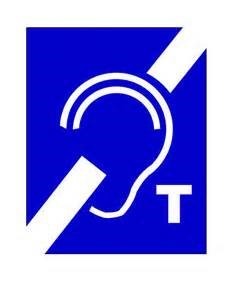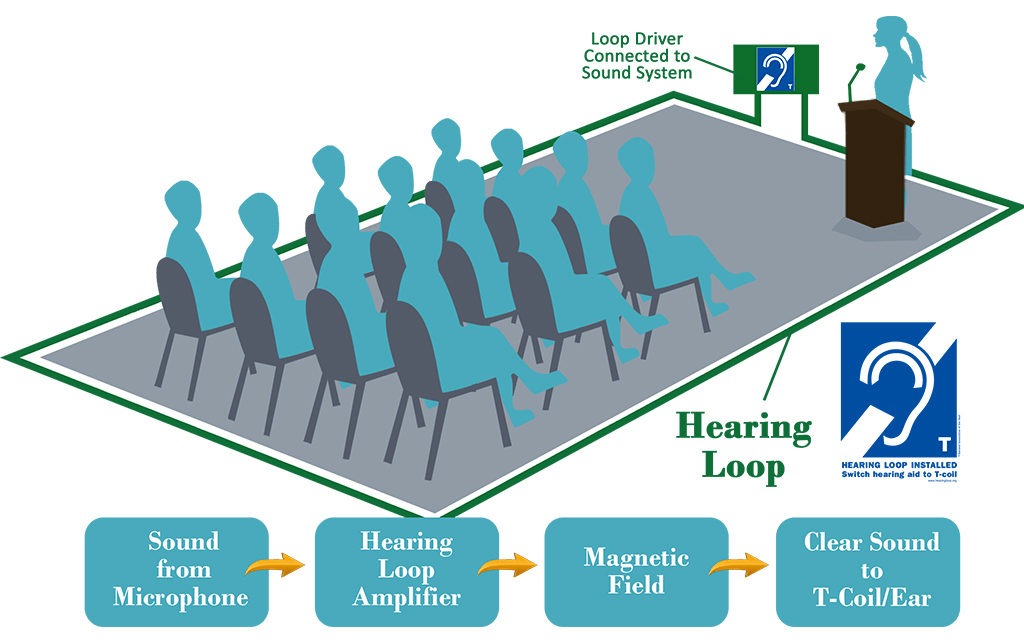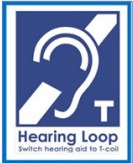On June 16, 2022, CHHA National announced the “Get in the Hearing Loop” campaign, a Canada wide communication access program dedicated to providing community education, advocacy on behalf of persons with hearing loss, and consultation services to help venues of all kinds improve hearing accessibility through hearing loop technology. CHHA-MB is getting in the hearing loop and we ask that all our members join us in making fellow Manitobans aware of the need for induction hearing loops and the benefits they provide for those with hearing loss.
Why is CHHA-MB promoting loop systems? Hearing loops are the most user-friendly of the assistive listening options for public venues. They provide simple and immediate communication access that delivers individualized, clear high-quality sound. They have been used in Europe for the past 25 years and are becoming increasingly popular in Canada and the USA. Hearing loops work with all brands of hearing aids equipped with an activated telecoil program and they do not increase the drain on batteries as other streaming devices may do.
We encourage all hearing aid users to check with their hearing health providers to find out if you have telecoils in your hearing aids. The back page of this newsletter is an info sheet that you can take with you when you visit your provider to help with questions about telecoils. If you do not have telecoils in your hearing aid or do not yet have aids you can still take advantage of a hearing loop by borrowing a headset and receiver at the venue.
More information on hearing loops will be coming on our website in the future and CHHA National has information at getinthehearingloop.ca.
Hearing looped venues are identified with the following symbol.

Hearing Loop System

But?? What is a Hearing Loop and What Does it Do?
A hearing loop also known as an Induction or Audio Loop provides a magnetic, wireless signal that is picked up by the hearing aid when it is set to the T-Coil (Telecoil) setting. Since the signal is being delivered directly to the hearing aid or cochlear implant, the sound is customized to each individual hearing loss.
How Does it Work?
The loop system consists of a microphone which picks up the sound source (i.e., a voice); the amplifier which processes the signal then sends it through to the induction loop, a wire placed around the perimeter of a room or sanctuary to act as an antenna that radiates the magnetic signal which is then picked up by T-Coil activated hearing aids or cochlear implant.
What is a Telecoil?
A telecoil is a coil of wire in a hearing aid or cochlear implant that receives electromagnetic signals generated by audio induction loops for conversion into sound. The T-coils receive the magnetic sounds signals inside looped venues and converts the magnetic signal back to audio signals that can be heard and understood. Most hearing aid models- 80% – come either a telecoil or offer it as an option (all cochlear implants processors made today have them). When buying a hearing aid, consumers should always ask that a telecoil be included and that audiologists or dispensers activate the telecoil program at the time of fitting and explain its use.
Together, these components, microphone, hearing loop driver and wire, and a telecoil activated hearing aid or cochlear implant, form a hearing loop system.


For Audiologists an Hearing Aid Providers
Please advise me if my hearing device(s) has a telicoil(s) /T-Coil. If they do, please activate and program them for use in a hearing loop. Also please write instructions for their use on the back of this card. If I don’t have a T-coil(s), can my device(s) be retrofitted or is there any accessory remote control / streamer telicoil option ?
Program Recommendations
For Open RIC fittings: manual T only program
For Closed / Occluded fittings: manual M + T program in social settings
For Closed / Occluded Fittings: manual T only program for high noise environments like airports or train stations.
Verify mic and telicoil responses. Match in Gain, Output and Frequency response in user programmed mode (use ANSI SPLIV test procedure .)
I would like to use my T-coil(s) in a hearing loop or with a neck loop and an assistive listening device or system.
Please write clear instructions on ow to use my manually accessible telicoil program.
For example: the numbered position of the program, number of beeps or voice prompt,and location of the switch to activate the T-coil.
Please write instructions here.

Audiologist or Hearing Aid Provider Name and Contact Information
